Did you know that heating your home can account for nearly half of your annual energy bill? The good news: choosing the right home heating solutions can dramatically lower your expenses while making every room feel cozy. With modern options like heat pumps, radiant floor heat, and smart thermostats, it has never been easier—or smarter—to keep your family warm, slash costs, and help the planet. In this comprehensive guide, you’ll uncover the best heating systems for every budget, learn about cutting-edge advancements, and discover strategies to boost comfort all winter long.
A Surprising Fact: How Home Heating Solutions Impact Your Energy Bills
- Home heating accounts for nearly 50% of the average household’s energy use.
It's a fact that surprises many: almost half of your household’s energy consumption goes into home heating . That means the heating system you choose doesn't just control your comfort—it has a huge influence on your utility costs, too. From fuel oil guzzlers to ultra-efficient heat pumps , the costs can vary tremendously, not just in the upfront price but also in what you pay month after month.
The U.S. Department of Energy reports that smart choices and simple upgrades—like better insulation, weatherproofing, or switching to a modern heat pump —can cut your bills by up to 30% or more. And with energy prices rising, every percentage point in efficiency matters. So, finding the right home heating solutions is not just about warmth—it's about savings, sustainability, and smarter living. Let's explore how.

How to Choose Effective Home Heating Solutions for Your Home
- Assessing your home’s insulation and heat loss
- Identifying the most suitable heating systems for different property types
Start by evaluating your home's insulation because even the best home heating system will struggle if heat escapes through poorly sealed walls, windows, or doors. An energy audit (sometimes called a blower door test) can reveal where your house is losing heat, helping you prioritize improvements that maximize comfort and minimize energy waste. Proper insulation , attic sealing, and double-glazed windows often give the best ‘bang for your buck’ before considering any new heating systems .
Then, choose a heating system that fits your property. For instance, radiant floor heating excels in open-plan homes, while forced air is ideal for quick heat delivery in larger, multi-story houses. Townhomes might benefit from mini-split heat pumps, and historic homes can leverage pellet stoves for cost-effective, efficient heat. Each type offers different balances of cost, efficiency, and installation demands—so it’s vital to match the solution to your home’s unique needs and layout.
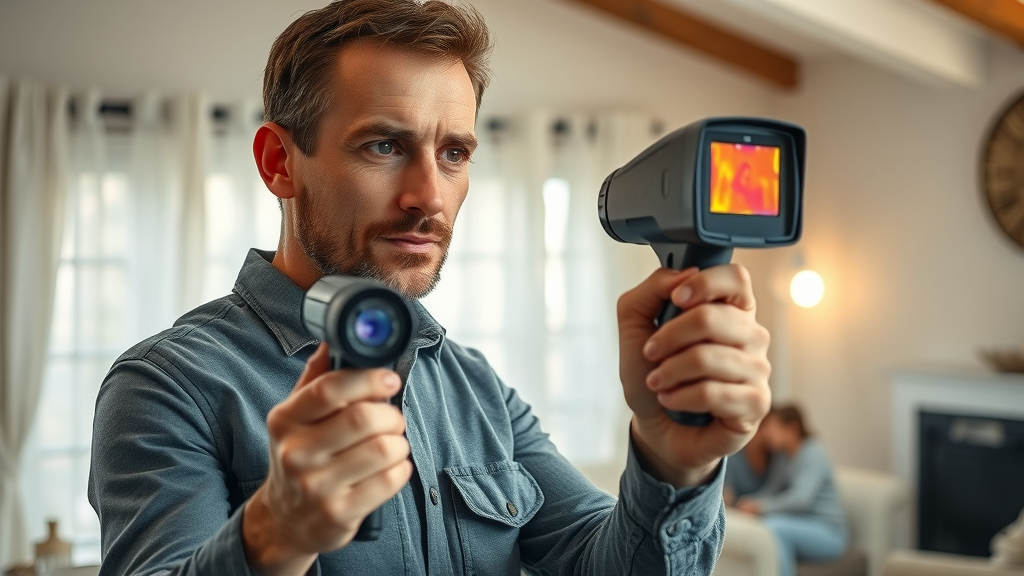
For homeowners interested in practical, step-by-step ways to maximize efficiency, exploring cost-effective heating strategies can provide actionable tips that complement your choice of system and help you get the most from your investment.
Essential Features of Modern Home Heating Systems
- Key advancements in heating system technology
- Comparing traditional vs. modern heating solutions
Today’s home heating solutions are a far cry from the old, inefficient oil burners or electric baseboard heat of decades past. Modern systems now offer smart zoning , remote controls, and schedule automation that actively manage your home’s comfort and minimize energy waste. For example, heat pumps can deliver both heating and cooling using one outdoor unit, while advanced radiant heat systems provide gentle, even warmth without blowing dust or allergens.
Traditional heating systems like gas furnaces or forced air setups can still play a role—especially in regions with very cold winters or where natural gas is inexpensive. However, newer heating technologies cut energy use dramatically, reduce carbon emissions, and often require less maintenance. Comparing your options side-by-side will help you see what makes sense for your home, budget, and long-term comfort.
Comparative Table: Home Heating Solutions and Their Costs
| Heating System | Upfront Cost | Running Cost | Efficiency | Maintenance |
|---|---|---|---|---|
| Heat Pump | $$$ | $ | Very High | Low |
| Forced Air | $$ | $$ | Moderate | Medium |
| Radiant Heat (Floor or Panel) | $$-$$$ | $ | High | Low |
| Pellet Stove | $$ | $ | High | Medium |
| Wood Stove | $-$$ | $ | Varies | High |
| Air Furnace | $$ | $$-$$$ | Average | Medium |
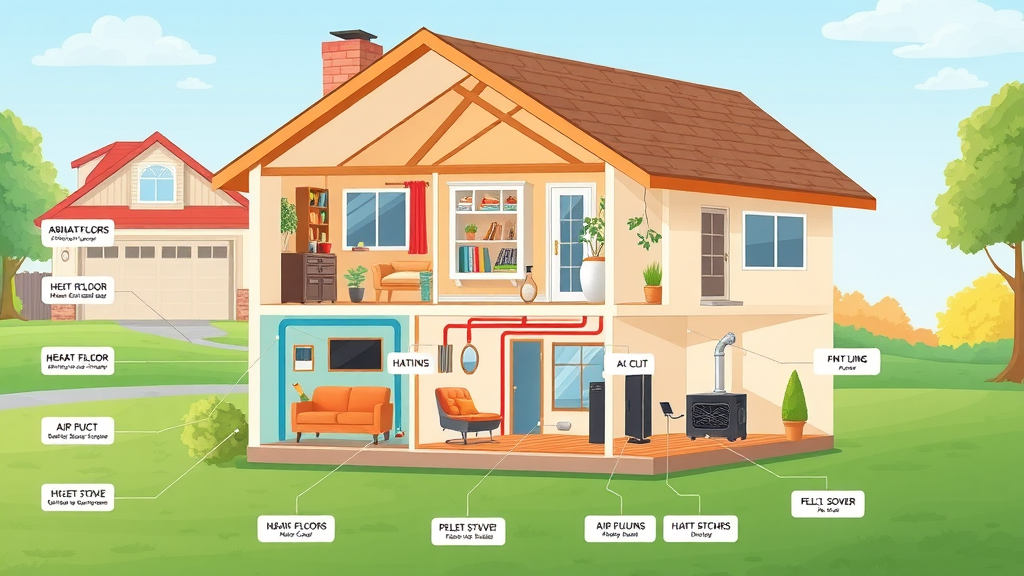
Types of Home Heating Solutions: Finding the Right Heating System
Forced Air Heating Systems: Pros, Cons, and Best Applications
- How forced air heating works
- Typical use cases and efficiency levels
Forced air heating systems —the classic setup in many American homes—use a furnace to heat air that is then pushed through a ductwork system by a blower fan. This heated air fills your rooms quickly, providing fast comfort, and can be easily paired with air conditioning for year-round climate control. Forced air works well in larger homes and is a solid choice if you already have ducts or desire an integrated heating and cooling system.
However, forced air systems aren’t perfect. Duct leaks and poor insulation can waste energy, and air movement may stir up dust and allergens. Efficiency ranges from moderate to high, especially with upgraded gas furnaces or newer electric models. Regular filter changes and duct cleaning help maintain performance.
Radiant Heat: Comfort and Efficiency
- Benefits of radiant floor and panel heating
- Suitability for different home layouts
Radiant heat offers a luxurious, spa-like experience, warming your home by circulating hot water or electricity through floors or wall panels. Unlike forced air, which blows heated air, radiant systems transfer heat directly to people and objects, providing even, allergy-free warmth. They're especially popular in bathrooms, kitchens, and open floor plans.
One of the biggest benefits is efficiency: radiant systems can be up to 30% more efficient than forced air, especially when paired with modern condensing boilers or heat pumps. While radiant heat may require a higher upfront investment and is simplest to install during new construction or major renovations, its comfort and low running cost pay off quickly in energy savings.
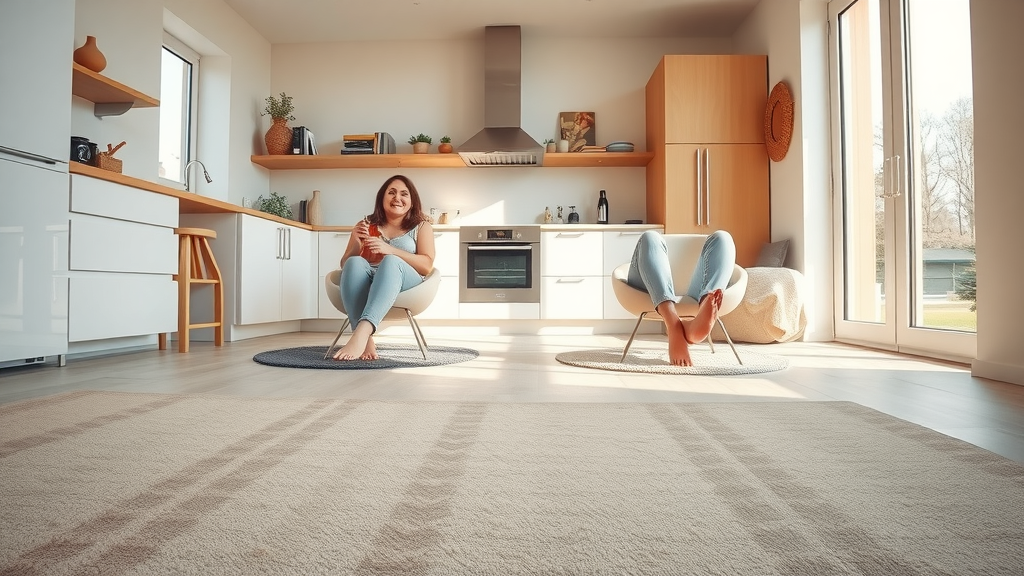
Heat Pumps: Energy Savings and Versatility
- Types of heat pumps and their performance
- Heat pumps versus standard heating systems
Increasingly the top pick for homeowners, heat pumps use electricity to move heat from outside to inside—even in chilly weather. There are two main types: air-source heat pumps (which extract warmth from the air) and ground-source or geothermal heat pumps (which pull steady heat from the ground). Because they transfer—rather than generate—heat, their efficiency can be 3-4 times higher than traditional furnaces.
Modern models excel in most climates, offering both heating and cooling with a single system and lower carbon emissions. Heat pumps usually have higher upfront costs, especially for ground-source types, but their low running cost and versatility often offset that over a few years, making them one of the most cost-effective and energy-efficient home heating solutions available.
Air Furnace Systems: When Are They Best?
- Air furnace operation and efficiency
- Common challenges and maintenance tips
Air furnace systems , another variant of forced-air setups, operate by using natural gas, oil, or electricity to heat air in a central unit before pushing it through your ductwork. These systems are widespread in colder states where powerful, on-demand heat is needed to keep up with icy winters. The latest gas furnace models boast efficiencies above 95%, wasting very little fuel.
However, air furnaces can suffer from uneven heating, drafts, and occasional blower or ignition issues. Maintenance is key—replace filters every 1-3 months, check pilot lights, and have annual tune-ups to keep your system running smoothly and efficiently.
Pellet Stoves and Wood Stoves: Sustainable and Traditional Choices
- Comparing modern pellet stoves vs classic wood stoves
- Environmental impact and running costs
Pellet stoves and wood stoves are time-tested, eco-friendly heating solutions for homes that have access to renewable fuel sources. Modern pellet stoves burn compressed wood pellets, offering cleaner combustion and higher efficiency than traditional log-burning stoves. They are easy to operate, have programmable feeds, and emit far less smoke—making them a smart choice for both rural and suburban settings.
Traditional wood stoves still appeal to those seeking independence from utility companies, as well as providing gentle, consistent heat that’s ideal during power outages. However, they do require more effort—chopping, storing, and regularly stoking the fire. Both systems offer low running costs if fuel is readily available, but regular cleaning and proper installation are essential for safety and best performance.
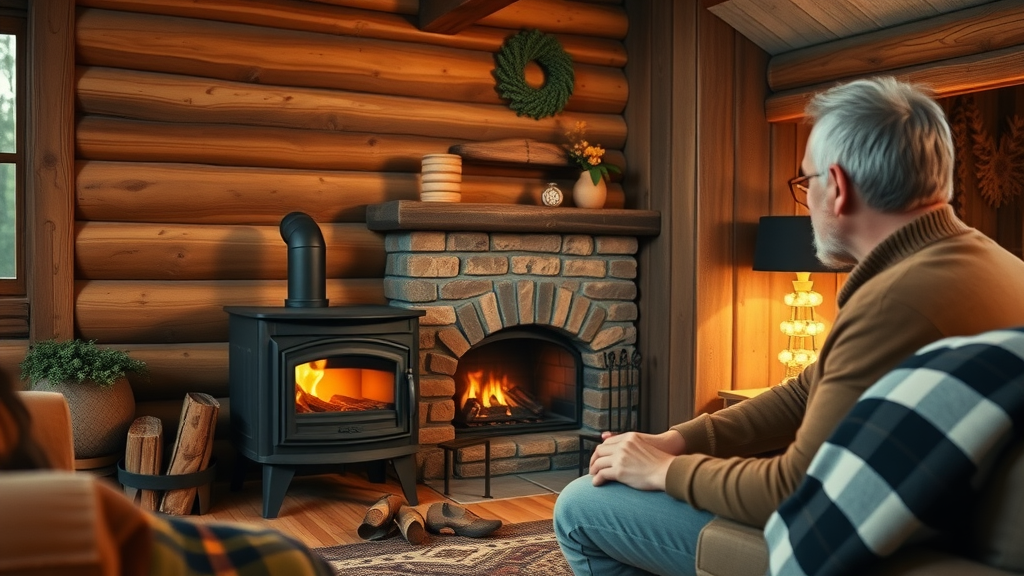
Hot Water and Water Heater Options for Home Heating
- How hot water heating complements traditional solutions
- Selecting water heaters for optimal efficiency
Many efficient home heating solutions rely on hot water as a heat source, whether for radiant floor heat or as part of your entire home’s hydronic heating system . Hot water heaters deliver consistent warmth, and when paired with modern boilers or indirect-fired water heaters, can be remarkably efficient. Some setups even use solar water heaters to pre-heat water, cutting fossil fuel use and bills further.
When selecting a water heater, consider energy ratings and size to match your household needs. Tankless heaters provide endless hot water with high efficiency, while traditional tanks are more affordable but can lose energy through standby heat loss. Combining the right water heater with effective insulation and thermostatic controls ensures your home stays warm and your energy bills stay low.
Video Guide: How to Evaluate Home Heating Solutions for Maximum Savings
Watch this video to compare popular home heating solutions , see efficiency charts, and hear experts explain which systems offer the best value in real-life scenarios.
Smart Upgrades: Boost Comfort with Modern Heating Controls
- Integrating smart thermostats and zoning controls
- Benefits for energy management and comfort
Installing a smart thermostat or zoning system is one of the easiest ways to turn any home into an energy-saving powerhouse. Modern controls allow you to create personalized heating schedules for different rooms or zones, adjust settings remotely from your phone, and even learn your routine for effortless comfort and energy savings .
By only heating rooms when they’re occupied, or reducing heat while you’re asleep or away, you can cut annual heating costs by 10-20%. Many models work with most existing heating systems —from forced air to radiant heat —and some even integrate with voice assistants for complete hands-free control. The result: greater comfort, reduced waste, and a more intelligent home heating solution overall.

Energy-Efficient Home Heating Strategies That Pay Off
- Best practices for heat retention and insulation
- Regular maintenance tips for all types of heating systems
Energy efficiency isn’t just about the type of heating system you use—it’s also about how well your home keeps the heat inside. Seal drafts with weather stripping, add insulation in attics and walls, and upgrade old windows to double-paned glass. Simple DIY projects like sealing gaps and insulating hot water pipes can bring quick savings.
Just as important is regular maintenance . For any home heating solution , annual checks by a professional can catch minor issues before they turn into expensive repairs. Clean filters, lubricate moving parts, and check thermostats and controls—these easy steps ensure maximum efficiency, safety, and savings year after year.

List: Top 7 Home Heating Solutions for Every Budget
- Heat Pump Systems
- Radiant Heat (Floor or Panels)
- Forced Air Furnaces
- Air Furnace Systems
- Pellet Stoves
- Wood Stoves
- Hot Water (Hydronic) Systems
“The most efficient home heating solutions not only reduce your energy bills—they also enhance your comfort and environmental footprint.” – Industry Expert
People Also Ask: What is the best heating solution for a house?
- The best home heating solutions depend on your climate, home size, insulation, and preferences. Heat pumps and radiant heating are highly efficient choices for most climates, while forced air and furnaces excel in colder regions.
People Also Ask: What is the cheapest method to heat your home?
- The cheapest method is often a modern heat pump or upgrading insulation and weatherproofing, but in some areas, pellet stoves or high-efficiency wood stoves can offer very low ongoing costs.
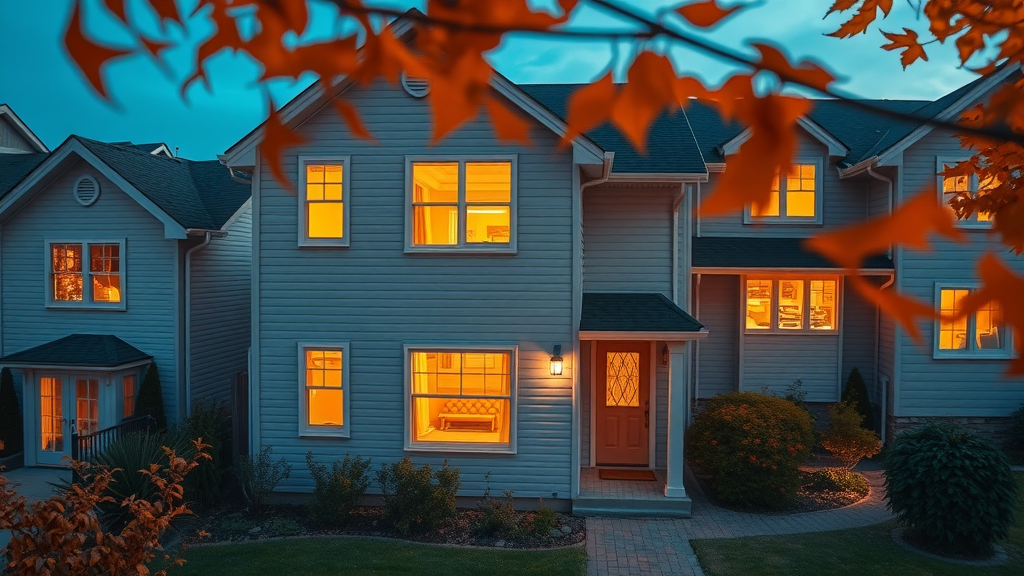
People Also Ask: What is the most efficient form of house heating?
- Heat pumps , especially ground-source models, are generally the most efficient form of home heating due to their high coefficient of performance and ability to transfer heat rather than generate it.
People Also Ask: What is the cheapest thing to heat your house with?
- For most homes, careful insulation combined with a heat pump or pellet stove can deliver the lowest overall heating costs while keeping you comfortable.
Selecting the Right Home Heating System for Your Needs
- Factors to consider: climate, home layout, initial investment, fuel availability
- Matching the home heating solution to your lifestyle and comfort demands
Choosing the perfect home heating solution starts with a checklist. Consider your climate—cold, moderate, or mild—as well as your home’s layout and square footage. Think about available fuels: is natural gas, electricity, or wood easy to get and affordable in your area? Factor in your budget not just for installation, but long-term running and maintenance costs. And don’t forget comfort—a system that keeps every room at the right temperature, quietly and cleanly, is always worth the investment.
Consult with experts or use online comparison tools to weigh the pros and cons, then match your final choice to your lifestyle—whether you're home all day or away frequently, whether you want automated controls or simple operation, your home heating solutions should fit your needs today and in the future.
See real-world examples of smart thermostat installations, zoning systems, and energy-saving techniques applied in homes just like yours.
Common Questions About Home Heating Solutions
-
How do I maintain my heating system for maximum efficiency?
Regularly change filters, check for leaks or blockages, schedule professional inspections annually, and keep vents and ducts clean. Well-maintained systems run better, save energy, and last longer.
-
When should I replace my home heating system?
If your system is over 15 years old, requires frequent repairs, or energy bills are rising, it may be time for an upgrade. Modern heating solutions offer much higher efficiency, safety, and comfort.
-
Are there government incentives for upgrading heating systems?
Many local and federal programs provide rebates for installing energy-efficient heat pumps , smart controls, and improved insulation. Check with your utility or local energy authority for current offers.
-
How can I tell if my home heating system is inefficient?
Signs include uneven temperature, noisy operation, rising energy bills, increased dust, and failing to meet thermostat settings. An energy audit or consultation can help diagnose exact issues and recommend improvements.
Video Tutorial: Step-by-Step Guide to Improving Your Home Heating Solutions
Learn hands-on steps to evaluate, upgrade, and maintain your home heating solutions for comfort and savings.
Quick Reference: Home Heating System Comparison Table
| System | Pros | Cons | Best Uses | Cost-Effectiveness |
|---|---|---|---|---|
| Heat Pump | Energy efficient, low emissions, heating & cooling | Less effective in extreme cold (air-source), higher initial cost | Moderate climates, energy-conscious homes | Excellent |
| Radiant Heat | Even warmth, no moving air, allergy-friendly | High install cost, best for new builds/renos | Open floor plans, bathrooms, luxury homes | Very Good |
| Forced Air | Quick heat, pairs with AC, widespread | Can stir allergens, duct leaks possible | Larger homes, integrated systems | Good |
| Pellet Stove | Renewable, low running cost, efficient | Fuel storage required, regular cleaning | Rural, eco-conscious homes | Very Good |
| Wood Stove | Independence, works off-grid | Manual labor, emissions, safety concern | Cabins, rural, backup heating | Good |
| Air Furnace | Strong heat, works with ducts | Moderate efficiency, noise | Cold climates, existing ductwork | Average |
Key Insights into Modern Home Heating Solutions
- Understanding heat loss to maximize savings
- Innovative technologies making a difference
- Final checklist for selecting and upgrading your home heating system
Grasping how heat is lost lets you target your efforts for the fastest results: seal those drafts, top up attic insulation, and prioritize repairs. Modern heating technologies—like variable-speed heat pumps , smart controls, and hybrid systems—raise the bar for both comfort and savings. Before committing, run through a final checklist: insulation status, system age, fuel types, control upgrades, and your budget. Taking this holistic approach ensures your home heating solution delivers year-round comfort and lower energy bills, today and for years to come.
Take the Next Step Toward Better Home Heating Solutions
- For expert help or advice visit Peak Underfloor Heating at https://peakunderfloorheating.com/
If you’re ready to take your home’s comfort and efficiency to the next level, consider exploring the latest in smart home heating solutions . Discover how intelligent controls, automation, and eco-conscious upgrades can transform your living space while delivering long-term savings. Whether you’re planning a renovation or simply want to future-proof your home, these advanced strategies offer a pathway to a warmer, greener, and more cost-effective household. Dive deeper and unlock the full potential of your home heating investment.
Sources
- Energy Saver – https://www.energy.gov/energysaver/home-heating-systems
- EPA – https://www.epa.gov/rhc/learn-about-wood-stoves-and-pellet-stoves
- Energy Saver – https://www.energy.gov/energysaver/radiant-heating
- Energy Star – https://www.energystar.gov/products/heat_pumps
- Peak Underfloor Heating – https://peakunderfloorheating.com/
To further enhance your understanding of home heating solutions, consider exploring the following resources:
-
“How to Lower Your Home Energy Bill” : This article provides practical steps to improve energy efficiency, such as insulating your attic and switching to a heat pump, which can lead to significant savings on your energy bills. ( time.com )
-
“Considering Underfloor Heating? How to Choose the Right System for Your Project” : This guide delves into the benefits and considerations of underfloor heating systems, helping you determine the best fit for your home. ( homebuilding.co.uk )
If you’re serious about optimizing your home’s heating efficiency and comfort, these resources will provide valuable insights and guidance.
 Add Row
Add Row  Add
Add 









Write A Comment